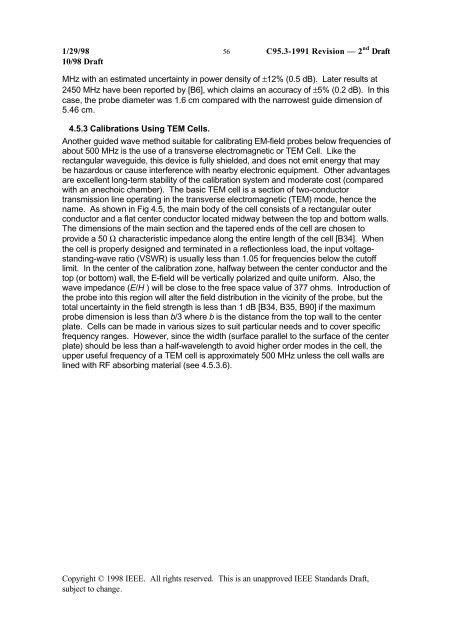DRAFT Recommended Practice for Measurements and ...
DRAFT Recommended Practice for Measurements and ...
DRAFT Recommended Practice for Measurements and ...
You also want an ePaper? Increase the reach of your titles
YUMPU automatically turns print PDFs into web optimized ePapers that Google loves.
1/29/98 56 C95.3-1991 Revision — 2 nd Draft<br />
10/98 Draft<br />
MHz with an estimated uncertainty in power density of ±12% (0.5 dB). Later results at<br />
2450 MHz have been reported by [B6], which claims an accuracy of ±5% (0.2 dB). In this<br />
case, the probe diameter was 1.6 cm compared with the narrowest guide dimension of<br />
5.46 cm.<br />
4.5.3 Calibrations Using TEM Cells.<br />
Another guided wave method suitable <strong>for</strong> calibrating EM-field probes below frequencies of<br />
about 500 MHz is the use of a transverse electromagnetic or TEM Cell. Like the<br />
rectangular waveguide, this device is fully shielded, <strong>and</strong> does not emit energy that may<br />
be hazardous or cause interference with nearby electronic equipment. Other advantages<br />
are excellent long-term stability of the calibration system <strong>and</strong> moderate cost (compared<br />
with an anechoic chamber). The basic TEM cell is a section of two-conductor<br />
transmission line operating in the transverse electromagnetic (TEM) mode, hence the<br />
name. As shown in Fig 4.5, the main body of the cell consists of a rectangular outer<br />
conductor <strong>and</strong> a flat center conductor located midway between the top <strong>and</strong> bottom walls.<br />
The dimensions of the main section <strong>and</strong> the tapered ends of the cell are chosen to<br />
provide a 50 Ω characteristic impedance along the entire length of the cell [B34]. When<br />
the cell is properly designed <strong>and</strong> terminated in a reflectionless load, the input voltagest<strong>and</strong>ing-wave<br />
ratio (VSWR) is usually less than 1.05 <strong>for</strong> frequencies below the cutoff<br />
limit. In the center of the calibration zone, halfway between the center conductor <strong>and</strong> the<br />
top (or bottom) wall, the E-field will be vertically polarized <strong>and</strong> quite uni<strong>for</strong>m. Also, the<br />
wave impedance (E/H ) will be close to the free space value of 377 ohms. Introduction of<br />
the probe into this region will alter the field distribution in the vicinity of the probe, but the<br />
total uncertainty in the field strength is less than 1 dB [B34, B35, B90] if the maximum<br />
probe dimension is less than b/3 where b is the distance from the top wall to the center<br />
plate. Cells can be made in various sizes to suit particular needs <strong>and</strong> to cover specific<br />
frequency ranges. However, since the width (surface parallel to the surface of the center<br />
plate) should be less than a half-wavelength to avoid higher order modes in the cell, the<br />
upper useful frequency of a TEM cell is approximately 500 MHz unless the cell walls are<br />
lined with RF absorbing material (see 4.5.3.6).<br />
Copyright © 1998 IEEE. All rights reserved. This is an unapproved IEEE St<strong>and</strong>ards Draft,<br />
subject to change.
















